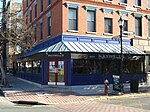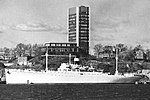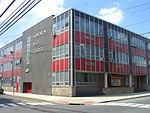Hoboken Shipyard
Hoboken Shipyard or Hoboken Yard or Beth Steel Hoboken (sometimes called The Plant) was a Bethlehem Shipbuilding Corporation shipyard that operated from 1938 to 1982 in Hoboken, New Jersey. Bethlehem Steel purchased the shipyard in 1938. The shipyard was founded in 1890 by the W. & A. Fletcher Company. In 1928 Fletcher sold the yard to United Dry Dock Company, called the Fletcher Plant. W. & A. Fletcher Co. was merged with five other New York-based shipbuilding/ship repair companies to form United Dry Docks, Inc. in February 1929. The yard has United States Navy contracts for ship repair. In November 1982 Eliot Braswell, with Hoboken Shipyard purchase the yard. The ship yead had been running at a loss when sold, Braswell was able to make cuts and keep the yard open. Braswell keep 103 workers and let the other go. Braswell also hired new workers. In 1999 the yard was closed and sold for 45 acres of land and waterfront development, including residences, retail space, public promenade and a waterfront park. The waterfront development is between 12th Street, 16th Street and the Hudson River at 40.752029°N 74.0235°W / 40.752029; -74.0235.Hoboken Historical Museum is last standing building of the former shipyard.
Excerpt from the Wikipedia article Hoboken Shipyard (License: CC BY-SA 3.0, Authors).Hoboken Shipyard
Sinatra Drive North,
Geographical coordinates (GPS) Address Nearby Places Show on map
Geographical coordinates (GPS)
| Latitude | Longitude |
|---|---|
| N 40.752029 ° | E -74.0235 ° |
Address
Shipyard Marina
Sinatra Drive North 1301
07030
New Jersey, United States
Open on Google Maps








